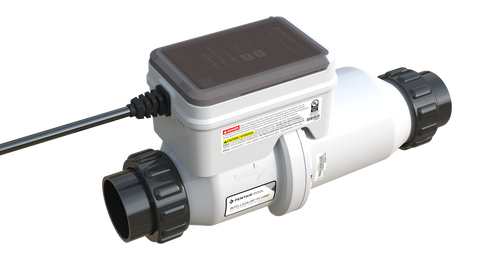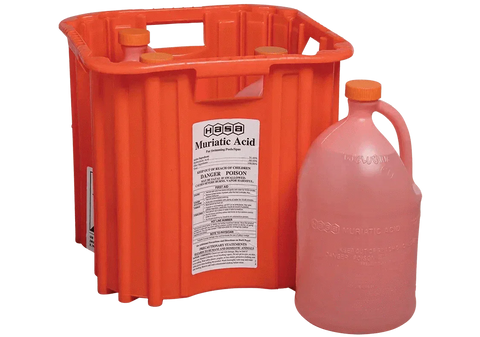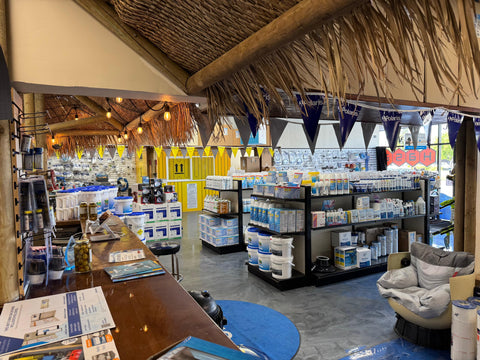The Science Behind Salt Water Pools
Salt water pool systems have become one of the most popular upgrades for homeowners who want to reduce chlorine handling and enjoy softer, gentler water. Instead of adding chlorine tablets or liquid, these systems use a salt cell (chlorine generator) to convert dissolved salt into chlorine through electrolysis.
The result is consistent sanitization without the harsh odor or irritation of traditional chlorine. However, saltwater systems come with their own set of maintenance requirements, particularly when water temperatures cool in fall and winter. Knowing how your salt system behaves during colder months—and managing acid use and corrosion—can help protect your investment and extend the life of your system.
How Salt Water Systems Work
At the heart of every salt system is the electrolytic cell, which passes a mild electric current through the water to generate chlorine.
Typical salt levels range from 2,500 to 3,500 ppm, depending on brand specifications. As chlorine sanitizes the water, it reverts to salt and the cycle continues automatically.
However, electrolysis raises pH and total alkalinity, meaning salt systems naturally require more frequent acid additions to keep chemistry in balance.
See our Muriatic Acid for Pools for safe and effective options.
Why Salt Systems Consume More Acid
The chemistry of chlorine generation produces hydrogen gas, which drives pH upward. Over time, this causes scaling and reduces chlorine effectiveness. To prevent that, acid must be added regularly to:
-
Keep pH in the 7.2–7.6 range
-
Prevent scale buildup inside the salt cell
-
Maintain sanitizing efficiency
Salt systems typically consume 50–75% more acid than standard chlorine pools. This is normal and expected—but it makes acid storage, handling, and dosing a routine part of saltwater maintenance.
Seasonal Shutdown: Why Salt Systems Turn Off in Cool Weather
When pool water drops below 60°F (15°C), most salt systems automatically shut off. This protects the cell and prevents inaccurate readings or damage.
At lower temperatures:
-
Electrolysis efficiency declines
-
Salt sensors may display “Low Salt” errors
-
Cell coatings can degrade if forced to run
If your control panel shows “Cold Water” or “Low Temp,” that’s normal. The system will resume operation automatically when water temperatures rise again.
During the off period, supplement sanitation manually using liquid chlorine or chlorine tablets until spring.
Explore liquid chlorine options to keep your pool sanitized during system downtime.
Corrosiveness and Equipment Concerns
Salt water is inherently more corrosive than standard pool water. Prolonged exposure can accelerate wear on:
-
Stainless steel rails, bolts, and anchors
-
Copper heater exchangers
-
Light rings and deck hardware
-
Metal fencing and furniture
To reduce corrosion:
-
Rinse metal components periodically with fresh water
-
Install zinc anodes to absorb stray electrical current
-
Keep salt levels within manufacturer specs
-
Inspect the cell and fittings each season
If you need replacement components, check out our Salt Cell Cleaners & Replacement Parts to keep your chlorinator performing efficiently.
Winter Care for Salt Water Pools
When preparing your saltwater pool for cooler weather, follow these best practices:
-
Turn Off the Salt Chlorinator – Confirm your controller is off once temps drop below 60°F.
-
Balance Water Chemistry – Adjust pH to 7.4, alkalinity to 80–120 ppm, and calcium hardness to 200–400 ppm.
-
Shock the Pool – Apply liquid chlorine or non-chlorine shock before covering.
-
Clean the Salt Cell – Soak in a mild acid solution (4:1 water to acid) to remove scale, then rinse thoroughly.
-
Check Salt Levels – After heavy rains or water loss, retest before spring start-up.
Proper winter care ensures your salt cell lasts longer and your pool starts the next season clean and balanced.
Pros and Cons of Salt Water Pool Systems
Advantages
-
Softer water feel
-
Continuous chlorine generation
-
Lower ongoing chemical cost
-
Fewer chloramines and less odor
-
Gentle on skin and eyes
Disadvantages
-
Higher initial investment
-
Increased acid demand
-
Greater corrosion risk if unmanaged
-
Seasonal system shutdowns
-
Regular cell cleaning required
Buy with Confidence from Benchmark Pool Supply
At Benchmark Pool Supply, we provide everything needed to maintain or upgrade your saltwater pool. Our inventory includes:
-
Professional-grade replacement salt cells
-
Muriatic acid and balancing chemicals
-
Salt system replacement cells for all major brands
With convenient locations in Fresno and Clovis, our experts help homeowners and professionals keep pools crystal clear and compliant all year long. Shop confidently knowing every product we carry is backed by trusted brands like Pentair, Hayward, and Jandy.
Frequently Asked Questions
Why does my salt system shut off when it’s cold?
Saltwater generators automatically disable below 60°F to prevent damage and because chlorine production becomes inefficient. Once the water warms up, the system restarts normally.
Do salt systems use more acid than chlorine pools?
Yes. The electrolysis process increases pH, causing saltwater pools to require more acid to maintain balance and prevent scale buildup.
Is saltwater more corrosive than regular pool water?
It can be. High salt levels and improper maintenance can corrode metal parts. Using zinc anodes and rinsing fixtures helps reduce corrosion.
Should I turn off my salt system in winter?
Yes. Once temperatures fall below 60°F, turn off the chlorinator and use manual chlorine treatments until the pool warms up.
What’s the best way to clean a salt cell?
Remove the cell and soak it in a 4:1 water-to-acid mix for several minutes to dissolve calcium scale, then rinse thoroughly before reinstalling.




